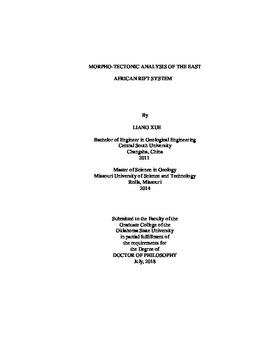| dc.description.abstract | Tectonic uplift of mountain ranges and plateaus have a significant impact on the geological record by influencing drainage systems and sediment supply, and on climate and on biogeography. Recent geomorphological, geochronological and geophysical studies have provided some understanding of time constraints and uplift rate distribution patterns, especially in convergent plate margins. Nevertheless, fewer studies took a comprehensive view over the topographic patterns, rates and changes in rates of tectonic uplift in continental rift systems. We do not know the how ground’s vertical motion is localized along the axis of rift and the relative roles of upwelling of magma and rift extensional processes play in tectonic uplift history. The East African Rift System (EARS) has long served as the ideal example of a continental rift to explore the distribution patterns, rates, and timing of tectonic uplift in the evolution of geomorphology. This work addresses fundamental questions of tectonic uplift and its footprint on the topography associated with rift systems. Specifically, three distinct segments along the EARS, the Rwenzori Mountains in the Western Branch, the southeastern Ethiopian Plateau in the Northern Branch and the Kenyan Rift in the Eastern Branch are investigated. The first chapter evaluated geomorphic proxies, including those obtained from bedrock streams (areal proxies including asymmetry factor (AF), mountain front sinuosity (Smf), hypsometric integral (HI), geophysical relief, and shape factor (Shp), and linear proxies including normalized steepness index (ksn), length-gradient index (SLk) and Chi gradient (Mχ)) in the Rwenzori Mountains, which represents an anomalously uplifted Precambrian horst within the western branch of the East African Rift system (EARS). This study aims to: (1) evaluate the usefulness of geomorphic proxies as recorders of drainage basin’s maturity and rock uplift rate; (2) evaluate the sensitivity of each geomorphic proxy to the drainage basin size and geometry, stream order, glaciers extent, and local structures; and (3) contribute to the understanding of morphotectonic evolution of the Rwenzori Mountains. For this, we computed the stream’s ‘Good of Fitness’ (R2, an indicator of the drainage basin’s maturity) and geomorphic proxies for the drainage basins and their streams in the Rwenzori Mountains from the Advanced Spaceborne Thermal Emission and Reflection Radiometer (ASTER) digital elevation model (DEM). Subsequently, we correlated the areal geomorphic proxies with each other and with R2. Also, we correlated the linear geomorphic proxies with each other and with published erosion rates obtained from cosmogenic 10Be analysis. Our results show that the areal geomorphic proxies (AF, Smf, HI, relief, and Shp), considering the drainage basin size and geometry, stream order, glacier extent, and local structures, can be applied to locally evaluate the maturity of the drainage basin. We also found that the linear geomorphic proxies (ksn, SLk, and Mχ) have strong positive correlation with the erosion rates, they are effective in detecting fault activities, and some of them (ksn and Mχ) are highly correlated with each other. Additionally, our geomorphic proxy results suggest that the north and south sectors of the Rwenzori Mountains are in relative tectonic quiescence but that the central sector is experiencing higher levels of erosion and rock uplift. The second chapter used morphotectonic analysis to study the tectonic uplift history of the southeastern Ethiopian Plateau (SEEP). Based on studies conducted on the Northwestern Ethiopian Plateau, steady-state and pulsed tectonic uplift models were proposed to explain the growth of the plateau since ~30 Ma. We test these two models for the largely unknown SEEP. We present the first quantitative morphotectonic study of the SEEP. First, in order to infer the spatial distribution of the tectonic uplift rates, we extract geomorphic proxies including normalized steepness index ksn, hypsometric integral HI, and chi integral χ from the Advanced Spaceborne Thermal Emission and Reflection Radiometer (ASTER) digital elevation model (DEM). Second, we compare these rates with the thickness of flood basalt that we estimated from geological maps. Third, to constrain the timing of regional tectonic uplift, we develop a knickpoint celerity model. Fourth, we compare our results to those from the Northwestern Ethiopian Plateau to suggest a possible mechanism to explain regional tectonic uplift of the entire Ethiopian Plateau. We find an increase in tectonic uplift rates from the southeastern escarpments of the Afar Depression in the northeast to that of the Main Ethiopian Rift to the southwest. We identify three regional tectonic uplift events at ~11.7, ~6.5, and ~4.5 Ma recorded by the development of regionally distributed knickpoints. This is in good agreement with ages of tectonic uplift events reported from the Northwestern Ethiopian Plateau. The third chapter examined the tectonic uplift history of the Kenya Rift (divided into a northern, a central, and a southern segment; henceforth NKR, CKR, and SKR) within the East African Rift System (EARS) by: (1) estimating the long-term (since Miocene - ~15 Ma) drainage incision pattern within the Kenya Rift by first obtaining the difference between modern topography and paleo-datum and then dividing the resulting regional incision by published ages of volcanic rocks; (2) characterizing the short-term (since Pliocene - ~4.5 Ma) drainage incision pattern and drainage basin divide migration using the chi integral geomorphic proxy; and (3) correlating the spatial and temporal drainage incision pattern with known magmatic, tectonic, and climatic events in the Kenya Rift. The long-term incision analysis shows that the incision rate is higher in the CKR averaging ~300 mm/ky since 4.5 Ma. Such Pliocene increase is also observed in other parts of the EARS. The short term incision analysis shows that the NKR is approaching steady state, while the CKR and SKR are still in transit state with active drainage basin divides migration. This work found that the spatial and temporal pattern of the tectonic uplift inferred from the drainage incision is well-correlated with known phases of magmatic activities. Also, this work found that the rapid increase in drainage incision since ~4.5 Ma correlated well with a major change in vegetation from grassland to woodland. This suggests that the tectonic uplift coupled with Pliocene magmatic activities have caused a major shift in the ecosystem in the region. | |
